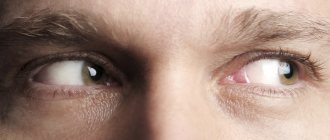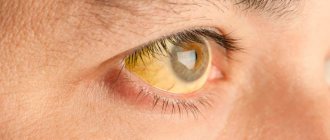Sometimes people who constantly use glasses begin to complain of pain in their eyes. If you take off the glasses, the pain goes away after a while. What could be causing this and how can I fix the problem?
Eye pain associated with prolonged wearing of glasses is most often not a sign of any disease. It is usually caused by fatigue of the eye muscles, which, in turn, is provoked by the incorrect selection of corrective agents.
Mechanisms of eye functioning
The eyes are one of the many organs that make up the visual system or visual analyzer. We do not see with our eyes; they act as an intermediary, transmitting information through the optic nerve, chiasm and visual tracts to certain areas of the cerebral cortex. The eyes are a pair of organs, and the correct functioning of each of them provides more than 90% of the information about the surrounding world.
The organs of vision are spherical in shape, which is why they are called “eyeballs.” The front of the eye is protected by the upper and lower eyelids. Eyeballs consist of the following elements:
- The cornea is the membrane that protects the front of the eye.
- The iris is a membrane colored in the same color as the eye.
- The pupil is a black round hole inside the cornea.
- The lens is the part of the eye that allows you to focus your gaze on distant and near objects.
- The retina is a thin layer of numerous photoreceptors.
- The vitreous body is a transparent, colorless substance that occupies 2/3 of the eyeball.
- The sclera is the white, opaque layer of the eye.
The structure of the eye is quite complex, and the mechanism of its operation can be compared to a camera:
- Light enters the eye through the cornea, which refracts it.
- The pupil adapts to the brightness of the light and changes it by adjusting the amount of light that passes through it.
- The lens is analogous to the lens in a camera, and it is behind it that light is focused. If it has the right shape and matches the length of the eye, then focusing on the retina allows you to get a clear picture, no matter how far away the object is.
- Photoreceptors in the retina absorb light and send it along nerve endings to the brain, which then translates it into an image.
The eye has a very complex structure, and with the normal and joint functioning of all elements of the eyeball, vision is clear. But even a slight malfunction of the cornea, retina or lens can lead to blurred vision, such as farsightedness, nearsightedness or astigmatism.
What happens during the period of getting used to new glasses?
For normal visual perception, all components of the eye must work correctly. However, dysfunction of at least one element of the visual system forces us to use modern methods of vision correction - glasses or contact lenses.
The period of getting used to new glasses can cause discomfort and unpleasant sensations, including dizziness or nausea. This is because the brain needs time to adapt to the new characteristics of the signals coming from the optic nerves. While getting used to new glasses, the lens adapts to the changes that are occurring.
Vision may improve, but discomfort may remain for some time. This is due to the fact that in new glasses the size of objects and the distance at which they are located are perceived in a distorted form. This is most often observed when wearing optics designed to correct farsightedness and astigmatism, as well as glasses with progressive lenses.
What is the cause of pain?
Any external change affects the state of the body, the same thing happens with the eyes. It doesn’t matter whether a person is using glasses for the first time or has changed them to stronger optics, the body must adapt to new conditions, which can cause some inconvenience.
Most often, pain in the eyes can occur when wearing glasses for a long time, but this does not mean that the painful sensations are a sign of any disease. Such sensations may be caused by fatigue of the eye muscles, which are constantly under tension. Fatigue, in turn, can be caused by an incorrectly selected corrective product.
If discomfort occurs in the first days after changing the optics, then this should be taken as normal, and it is too early to talk about incorrectly selected glasses. The brain gets used to one image of the surrounding picture, and when it changes suddenly, it has to adapt to it and process the changed image. In addition, the period of adaptation depends on various factors, including the age of the patient or the type of correction.
But if 2 or more weeks pass and your eyes are still not accustomed to the new optics and experience discomfort, the new glasses may not be suitable. The reason for this can be even the smallest detail, for example, high optical power of the lenses or irregular frame shape. Let's take a closer look at the most common causes of pain when wearing glasses.
Incorrect selection of diopters
This problem is considered the most common with eye pain. Typically, your doctor will prescribe lenses with a weaker optical power than what is needed for 100% vision.
Wearing high power lenses can cause headaches. In addition, a separate lens with different optical powers is selected for each eye. Often people buy glasses without a prescription, but this can not only cause discomfort, but also seriously harm their vision in the future.
Incorrect selection of the distance between lens centers
Incorrect focusing of spectacle lenses is a consequence of the fact that a person independently selects a means of vision correction without consulting an ophthalmologist. The increased distance between the optical centers of the lenses can cause the eyes to become overstrained and quickly get tired. In addition, wearing glasses with an incorrectly selected distance between the centers of the lenses can lead to a violation of the intercenter distance between the pupils, which in turn leads to a deterioration in image clarity and even the development of strabismus.
Price
Selection of glasses in public clinics is free. You only need to pay for the glasses themselves (the cost of the frames starts from 500 rubles, the work of a specialist starts from 1,500 rubles). Consultations with specialists from private clinics cost from 1,500 rubles.
Various gadgets that have become an integral part of the life of a modern person sometimes do not have the most favorable effect on his health. In particular, the need to constantly strain the eyes often leads to deterioration of vision and the need to correct it with glasses. Ophthalmology has advanced significantly in recent years, which makes the use of accessories as comfortable as possible. Despite this, cases of headaches from glasses are not uncommon.
Some people do not even suspect that their constant or systematic cephalalgia is associated with wearing products. Many people ignore the symptom and try to cope with it on their own. Over time, the problem acquires catastrophe proportions and only then do the victims turn to specialists. To prevent this situation, it is enough to purchase glasses according to your prescription, and not according to your feelings. At the first signs of discomfort, you should contact a therapist or ophthalmologist, and not try to cope with the pain with medications.
What to do if your eyes hurt while wearing glasses?
If pain in the eyes occurs, first of all you need to contact an ophthalmologist, as there is a risk of not only worsening, but also losing your vision. If you have problems with your vision, you need to periodically check its sharpness so as not to miss the moment and adjust the optical power of the lenses in time.
As we have already found out, the cause of such discomfort can be either an incorrectly selected frame or a violation in the selection of lenses or diopters. To correct your glasses, you need to go to an optician, undergo an additional examination and get advice from a specialist.
How to choose the right glasses?
Correctly selected glasses not only improve the image and give a clear picture, but also improve well-being, which could be worsened due to violation of the rules when selecting optics.
With prolonged tension, the eye muscles get tired, the picture deteriorates, and they will need even more effort to adjust comfortable vision. In order to avoid this, you need to choose a vision correction product that will prevent excessive tension in the eye muscles and their fatigue.
Glasses consist of lenses and a frame, and if a prescription for lenses is written by an ophthalmologist, then the frame must be selected at an optical salon. When selecting glasses, you should pay attention to the following nuances:
- Carefully examine the lenses for chips or scratches.
- The lenses must fit tightly inside the frame.
- Check the movement of the temples; to do this, you need to open and close the frame several times.
- It is important to check the fit of the glasses so that they fit well on the face and do not move when moving.
The quality of your vision can change over time, so you should have regular eye exams with your ophthalmologist. This will help you take timely measures to select the right corrective product to improve your vision.
If your eyes hurt from wearing sunglasses
Most often, the culprit is poor-quality optics or an incorrect shade of the filter. Experts do not recommend the blue-violet range, since it is poorly tolerated by the lens. The healthiest glasses for your eyes are glasses that are evenly darkened. Lenses with 50% tint are optimal for urban conditions; for mountains and beach holidays it is better to choose a more saturated tint. It is better to purchase sunglasses in specialized stores or opticians, be sure to require a certificate for the product.
Many people, unfortunately, perceive sunglasses as a fashion accessory rather than a way to protect their eyes from ultraviolet rays. In other words, buyers focus exclusively on the appearance of frames and glasses, and not on their functional features. Ultraviolet radiation has only a negative effect on the eyeballs. Sunlight can damage the retina, cornea and lens.
Sunglasses hurt your eyes when the frames are chosen incorrectly or a model with low-quality lenses is chosen. You should purchase such optics in specialized stores. Glass does not have to be dark. The main thing is that they are equipped with filters that block ultraviolet radiation.
It is also better to choose models with special coatings - polarizing, anti-reflective, hydrophobic. With these sunglasses you won't be bothered by glare. In addition, they reflect almost 100% of UV rays. There are glasses with a photochromic coating. They change their color and degree of light transmittance depending on the lighting level.
Risks of using cheap sunglasses:
- the lenses are unevenly darkened, so they transmit different amounts of light - this can increase or cause astigmatism;
- some glasses double the image, forcing the eyes to strain to give the picture the desired quality - this leads to deterioration of vision;
- Cheap frames often do not meet basic anatomical requirements, which leads to disruption of blood flow in certain areas of the head.
To purchase sunglasses, it is better to contact optical stores. Such products cannot be cheap, but if selected correctly they will last for several years. An additional advantage of such models is their ability to protect the delicate skin around the eyes from ultraviolet radiation. This reduces the risk of wrinkles forming in this area.
It also happens that your eyes start to hurt from wearing sunglasses. Pain occurs due to incorrect shades of light filters, poor-quality optics or an uncomfortable (“but very beautiful”) shape. For example, blue-violet shades are poorly tolerated by the lens of the eye. When purchasing glasses, you must ask for a certificate for the product, otherwise you may buy glasses with bad optics. The shade of the glasses should be more than 50%, otherwise you may feel discomfort.










